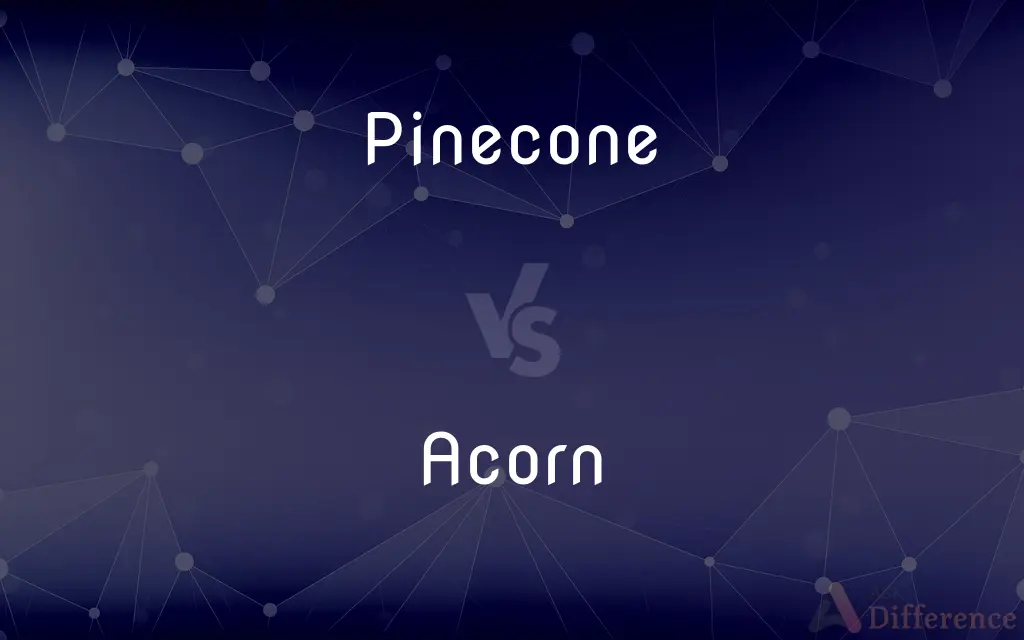Pinecone vs. Acorn — What's the Difference?
By Urooj Arif & Fiza Rafique — Updated on March 12, 2024
Pinecones are the seed-bearing cones of pine trees, often woody and spiraled, while acorns are the nut-like seeds of oak trees, enclosed in a tough shell with a cap.

Difference Between Pinecone and Acorn
Table of Contents
ADVERTISEMENT
Key Differences
Pinecones come from pine trees and serve as protective containers for their seeds, featuring woody, spiraled scales. Whereas acorns, produced by oak trees, are single seeds encased in a hard shell, topped with a distinctive cap, and are crucial for the reproduction of oak trees.
While pinecones open up to release their seeds when the conditions are right, acorns remain a singular, nut-like entity that detaches from the tree to potentially grow into a new oak tree. On the other hand, acorns are an important food source for wildlife, indicating their role in the ecosystem beyond just reproduction.
Pinecones vary greatly in size and shape depending on the pine species, showcasing a diversity in their physical characteristics. In contrast, acorns are more uniform in their general appearance but still exhibit variation in size and shape among different oak species.
The lifecycle of a pinecone involves maturing on the tree for a period before releasing its seeds, which can then be dispersed by wind or animals. Conversely, acorns fall to the ground and can be buried or transported by animals, which aids in their germination and the spread of oak trees.
Comparison Chart
Source
Pine trees
Oak trees
ADVERTISEMENT
Type
Seed-bearing cone
Nut-like seed
Composition
Woody, spiraled scales
Hard shell with a cap
Role in Reproduction
Protect and disperse seeds
Grow into new oak trees
Ecological Role
Dispersal of pine seeds, habitat for some species
Food source for wildlife, seed dispersal for oaks
Compare with Definitions
Pinecone
Pinecones are the reproductive structures of pine trees, containing seeds.
The pinecone fell from the tree, scattering its seeds.
Acorn
Acorns are the seeds of oak trees, enclosed in a tough shell.
Squirrels gathered acorns for the winter.
Pinecone
Pinecones have a distinctive woody texture and a spiraled shape.
She picked up a spiraled pinecone during her walk in the forest.
Acorn
Although not true nuts, acorns resemble nuts in their appearance.
The ground was littered with acorns under the oak tree.
Pinecone
Pinecones are often associated with winter and holiday decorations.
The mantelpiece was adorned with pinecones for the holiday season.
Acorn
Many animals rely on acorns as a food source.
Deer and birds feast on acorns in the autumn.
Pinecone
Pinecones can vary greatly in size depending on the species of pine.
The large pinecone was almost the size of a football.
Acorn
Acorns are known for their distinctive caps, which cover part of the nut.
The child collected acorns, fascinated by their little caps.
Pinecone
Some pinecones only release seeds in response to fire.
After the wildfire, the pinecones opened, releasing their seeds.
Acorn
Acorns are often seen as symbols of strength and potential.
The tiny acorn has the potential to grow into a mighty oak tree.
Pinecone
The cone of a pine tree.
Acorn
The acorn, or oaknut, is the nut of the oaks and their close relatives (genera Quercus and Lithocarpus, in the family Fagaceae). It usually contains one seed (occasionally two seeds), enclosed in a tough, leathery shell, and borne in a cup-shaped cupule.
Pinecone
A seed-bearing conical fruit of a pine tree.
Acorn
The fruit of an oak, consisting of a single-seeded, thick-walled nut set in a woody, cuplike base.
Pinecone
The seed-producing cone of a pine tree
Acorn
The fruit of the oak, being an oval nut growing in a woody cup or cupule.
Acorn
(nautical) A cone-shaped piece of wood on the point of the spindle above the vane, on the mast-head.
Acorn
(zoology) See acorn-shell.
Acorn
The glans penis.
Acorn
A testicle.
Acorn
The fruit of the oak, being an oval nut growing in a woody cup or cupule.
Acorn
A cone-shaped piece of wood on the point of the spindle above the vane, on the mast-head.
Acorn
See Acorn-shell.
Acorn
Fruit of the oak tree: a smooth thin-walled nut in a woody cup-shaped base
Common Curiosities
What are pinecones?
Pinecones are the seed-bearing structures of pine trees, characterized by their woody, spiraled scales.
Can both pinecones and acorns grow into trees?
Pinecones contain seeds that can grow into pine trees, while acorns themselves can germinate and grow into oak trees.
How do animals interact with pinecones and acorns?
Animals may use pinecones for shelter or food (seeds), while acorns are a significant food source for various wildlife.
How do pinecones differ from acorns in their ecological role?
Pinecones aid in the dispersal of pine seeds and provide habitat for some species, while acorns serve as a crucial food source for wildlife and aid in the dispersal of oak seeds.
Do pinecones and acorns appear at the same time of year?
The appearance of pinecones and acorns varies by species and location, but they often mature and fall during late summer to autumn.
How long does it take for an acorn to germinate?
Acorn germination can vary, but it typically begins in the spring following dispersal if conditions are favorable.
Are pinecones used in any cultural or symbolic ways?
Pinecones are often used in holiday decorations and can symbolize immortality and enlightenment in various cultures.
What is the significance of acorns in folklore or symbolism?
Acorns are symbols of potential and strength, often associated with growth and resilience in various cultures.
Are pinecones and acorns edible?
Some pinecone seeds are edible and considered a delicacy, while acorns can be eaten after leaching out tannins but are more commonly consumed by wildlife.
Do all oak trees produce acorns?
Yes, all oak trees produce acorns, which are their seeds, but the size and shape can vary among species.
What are acorns?
Acorns are the seeds of oak trees, encased in a hard shell with a cap, resembling a nut in appearance.
Are all pinecones similar in size and shape?
Pinecones vary widely in size and shape depending on the species of pine.
Can the presence of pinecones or acorns indicate the type of tree?
Yes, the presence of pinecones indicates pine trees, while acorns indicate oak trees.
How long does it take for a pinecone to mature?
The maturation time for pinecones can vary, typically ranging from a year to several years depending on the species.
How do fire-adapted pinecones differ from regular pinecones?
Fire-adapted pinecones have evolved to open and release their seeds only in response to the heat of a fire, aiding in the regeneration of forests after wildfires.
Share Your Discovery

Previous Comparison
Andalusia vs. Catalonia
Next Comparison
Ultramafic vs. MaficAuthor Spotlight
Written by
Urooj ArifUrooj is a skilled content writer at Ask Difference, known for her exceptional ability to simplify complex topics into engaging and informative content. With a passion for research and a flair for clear, concise writing, she consistently delivers articles that resonate with our diverse audience.
Co-written by
Fiza RafiqueFiza Rafique is a skilled content writer at AskDifference.com, where she meticulously refines and enhances written pieces. Drawing from her vast editorial expertise, Fiza ensures clarity, accuracy, and precision in every article. Passionate about language, she continually seeks to elevate the quality of content for readers worldwide.
















































